Review of the WD Ultrastar HC560 20TB Hard Drive for NAS
The speed at which Hard Drive technology has evolved has been pretty crazy. Not so long ago, many highly respected journals and tech sites were signing the death warrant of Hard drives, largely down to the growing affordability of SSDs, NAND storage capacity and durability increasing and all the while HDDs plodding along with only relatively small improvements in their performance and cost. However, fast forward to 2022 and not only are HDDs still a ‘thing’ but, they continue to flourish! Why is this? Well, simply that the amount of data we as individuals and/or businesses is constantly increasing in volume, but so does the expected speed at which we demand access to it. SSDs give you great speed, but still cannot affordably match the price point per TB or even Petabyte of HDDs and in this world, a drive like the Western Digital Ultrastar DC HC560 20TB hard drive is going to be perfect. Designed with large-scale data center deployment in mind, the HC560 is a monster of a hard disk that includes a large number of innovations by WD to improve stability, performance, access times and workloads compared with regular desktop or NAS class HDDs. So, today I want to discuss the new Western Digital DC HC560 20TB, what makes it different to a Pro class drive, who it is designed for, who it ISN’T designed for and ultimately help you decide if it deserves your data. Let’s go.
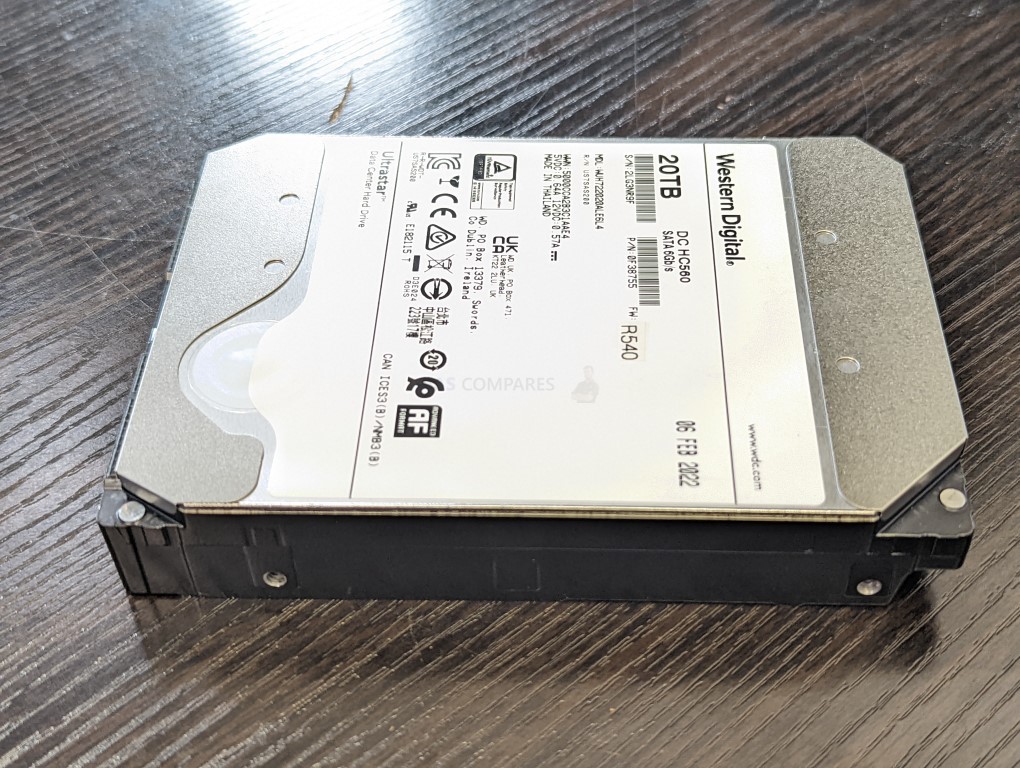
WD Ultrastar HC560 20TB Hard Drive Review – Quick Conclusion
The Western Digital DC HC560 does exactly what it sets out to achieve. This is an incredibly robust hard drive that you can tell WD has poured alot of that enterprise audience R&D into! The fact that it is 20TB is always going to be impressive, but the real draw here is that this high degree of storage capacity has been achieved, without SMR and without compromising it’s performance and use in a larger RAID environment. HDDs are still in popular industry use and until the ongoing demand for Large Affordable Capacity AND fast access continues, you can see why most popular hard drive brands are predicted to comfortably hit 50TB by the end of the decade. The Western Digital DC HC560 20TB hard disk is a great piece of engineering that continues to support the continued popularity of the Ultrastar series for large-scale data center use. However, it is REALLY important to understand WHY this drive is DC/Data-Center classed and not appropriate for the average home user looking to get big capacity in a single drive. For a start, the Western Digital DC HC560 is a noisy drive! Alongside a higher power consumption to keep this industrial drive running 24×7, it is a drive designed for exceptional fast power on/spin up, as well as having a nine spinning platters to dance between all the time, so it makes alot of humming, spinning, vibrating and clicking noises throughout it’s operations – in a data center, fulling populating a 24 bay rackmount, you won’t hear it. But in a modest home 2-4-Bay system, it sounds horrendous! Enterprise drives like the Western Digital DC HC560 20TB are designed for larger scale deployment and used in bulk (RAID configs), hence the lower price often when compared again NAS PRO drives like WD Red Pro. The Western Digital DC HC560 Ultrastar is an exceptional Hyper-Scale storage hard drive, just don’t try to use it outside of those environments!
Where to Buy a Product





![]()
![]()

VISIT RETAILER ➤






![]()
![]()

VISIT RETAILER ➤






![]()
![]()

VISIT RETAILER ➤






![]()
![]()

VISIT RETAILER ➤
WD Ultrastar HC560 20TB Hard Drive Review – Specifications
The Western Digital DC HC560 Ultrastar 20TB hard drive is, unsurprisingly, not a drive that is built like the rest. Aside from the hefty task of storing 20TB of data, this is a drive that is designed for deployment in much more industrial arrays, in near limitless storage pools (rackmount, bolted onto rackmount, etc, etc) and will be in operation 24×7, with regular access and a higher % of data recycling as data moves between hot>warm>cold storage systems. This combined with the need for the drive to maintain a sustainable performance (not just hit a high peak transfer rate, but be able to maintain it without over-saturation over long, long periods of time. Then there is the expectations of lifespan on a HDD like the Western Digital DC HC560 20TB, with the industry standard of 5 years really being a great deal more significantly when it comes to data center hardware.
Therefore, the hardware specifications of the Western Digital DC HC560 20TB are similar to those found in the WD Red Pro 20TB drive released around the same time, however, there is a greater focus on annual workloads, durability and lifespan of the drive when in constant use. With most regular/normal server class drives arriving with a 180TB write workload per year, Pro series drive support upto 300TB and Western Digital DC HC560 series a whopping 550TB annually – hence the much longer MTBF hour rating of 2.5 million. This combined with fixed 7200RPM and massive 512MB cache means that this is a drive that will run faster, even under sustained high use and do so in significantly larger RAID configurations. This does also result in a higher power consumption in use, standby or idle modes, as well as a larger general vibration when in use and a higher noise level when the drive is in operation (which climbs even higher during larger frequency but low size/volume access periods – ie those larger IOPS measurement based operations). Then there is the inclusion of OptiNAND from WD on these larger 18TB and 20TB HDDs, which we will touch on in a moment. Before then though, here are the full specifications of the Western Digital DC HC560 20TB HDD:
| Model Number | 0F38755 |
| Price | £389.99 at the time of writing |
| Formatted capacity | 20TB |
| Recording technology | EAMR (Energy Assisted Magnetic Recording) |
| Interface | SATA 6 Gb/s (SAS options are available) |
| Form factor | 3.5-inch |
| Native command queuing | Yes |
| Advanced Format (AF) | Yes |
| RoHS compliant5 | Yes |
| Controller | OptiNAND and iNAND, controller Combination SoC |
| SoC Architecture | 64-layer dynamic flash (BICS3) for metadata |
| Internal transfer rate | 269 / 257MB/s |
| Cache (MB) | 512 |
| RPM | 7200 |
| Platters | 9x 2.2TB |
| Load/unload cycles | 600,000 |
| Non-recoverable errors per bits read | <10 in 10 |
| MTBF (hours)8 | 2,500,000 |
| Workload rate (TB/year) | 550 |
| Limited warranty (years) | 5 |
| 12VDC ±5% (A, peak) | 2.0/3.2 |
| Read/Write Power Use | 7.0 (W) |
| Idle Power Use | 6.1 (W) |
| Standby and Sleep | 0.3 |
| Operating Temp | 5 to 60°C |
| Non-operating Temp | -40 to 70°C |
| Non-operating (2 ms) | 250 |
| Idle | 20 dBA |
| Seek (average) | 32 dBA |
| Height (in./mm, max) | 1.028/26.1 |
| Length (in./mm, max) | 5.787/147 |
| Width (in./mm, ± .01 in.) | 4/101.6 |
| Weight (lb/kg , ± 10%) | 1.52/0.69 |
What is OptiNAND and Why is it so Important?
Of course, users who have been following the developments of WD in their roadmaps and reveals of larger-scale drive media will be aware that the WD Ultrastar HC560 20TB also features a new technological design being rolled out in these bigger drives to merge existing storage technologies into something even better – OptiNAND. This is a new approach to an old idea that never really took off, where the benefits of small areas of faster NAND storage (more typically associated with SSD media) and affords a small area of NAND to a larger scale hard drive to be used for metadata and for storing data in the event of power failure. Flash is also interesting from a persistence standpoint. DRAM gets flushed on power loss, but NAND is non-volatile and can continue to keep metadata information without having to re-hydrate after a boot sequence, be removed from the system for some reason, or any other event where power drops. The WD Ultrastar HC560 20TB hard drive (much like other Western Digital 20TB drives currently) arrives with a portion of 64-layer/64GB BICS3 (3D TLC)
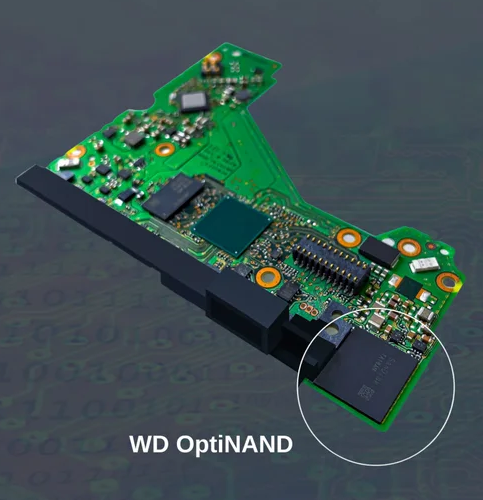
WD states that OptiNAND drives can secure more than 100MB of write cache data in the event of an unplanned power loss, a 50X improvement over standard drives that can flush about 2MB. Hybrid Drive media is not new, but whereas older generation hybrid drives were more parallel in architecture, this is far more intertwined. It also brings enhancements to the firmware algorithm and system-on-a-chip (SoC). Once again, to be clear, OptiNAND and its iNAND isn’t flash cache (such as the 512MB this drive also features). Rather, it’s a portion of flash memory used to store metadata–or data about existing data–so they can be managed more efficiently.
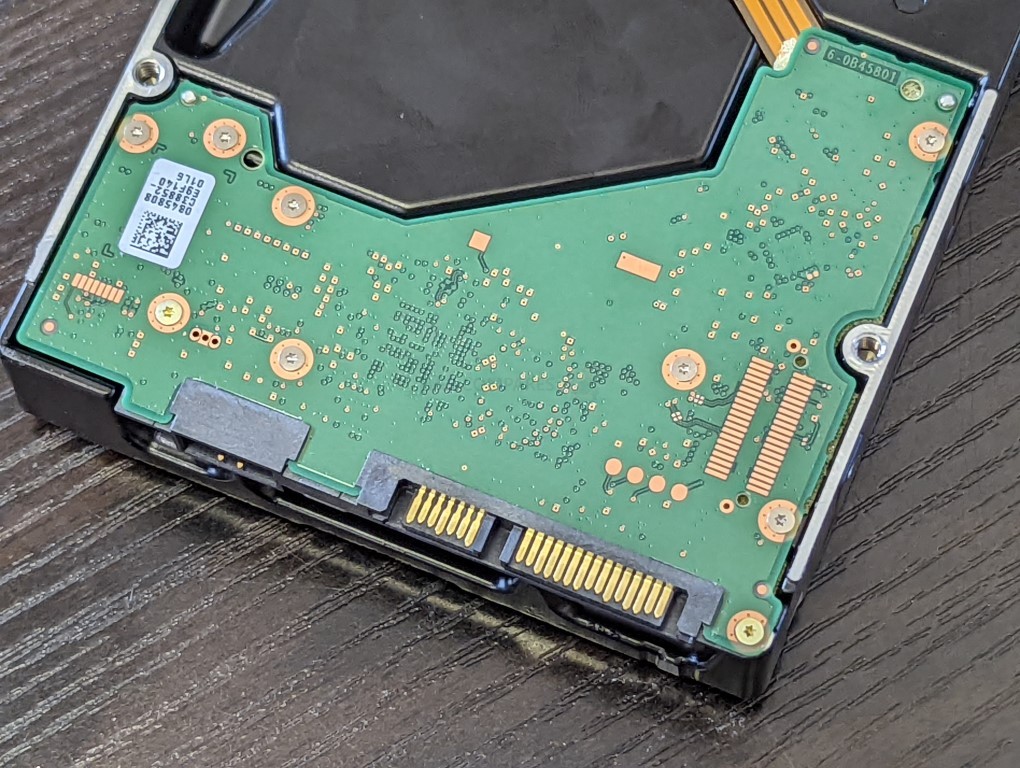
The slice of iNAND has its own dedicated controller, much like an SSD. While metadata management itself doesn’t help to increase platter density, it enables a range of benefits that do. As one can imagine, the higher the density of the HDD, the more metadata it generates. Moving metadata to a fast, dense and scalable storage area gives more freedom for manufacturers to create higher capacity drives.
| OptiNAND | DRAM |
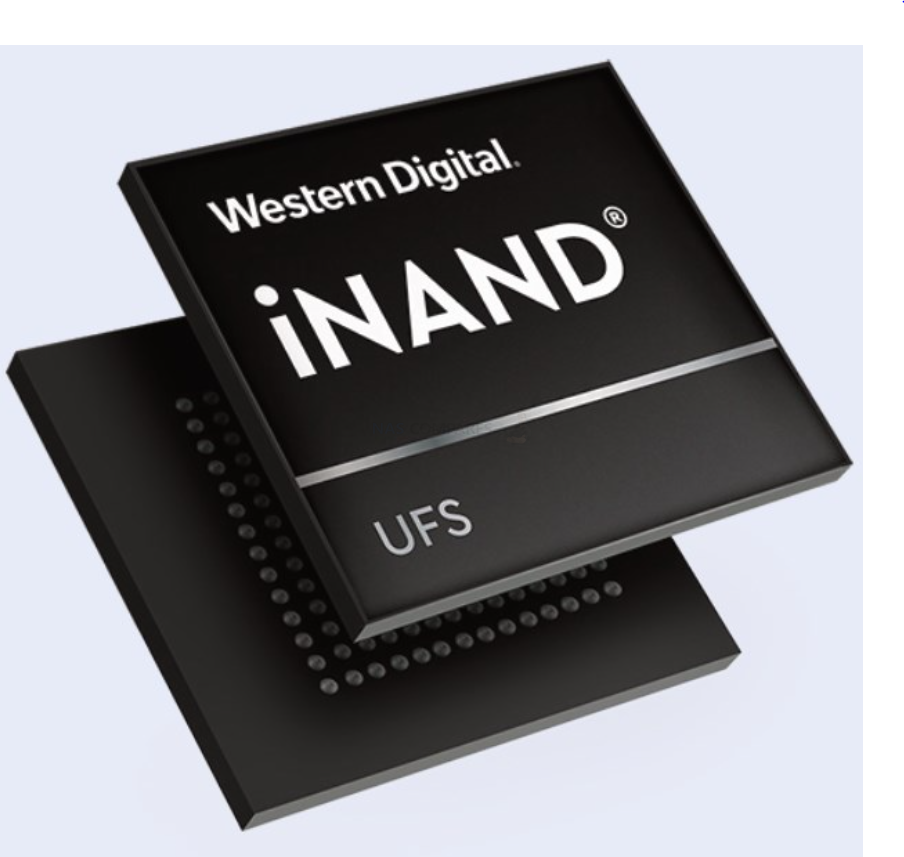 |
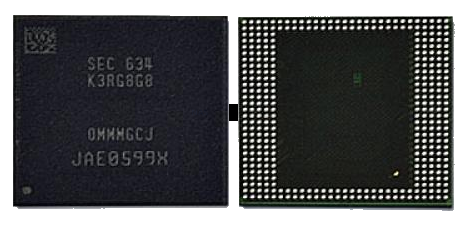 |
But why choose NAND over DRAM? Western Digital explained back in August 2021 that modern high-density HDDs generate gigabytes of metadata and it’s too costly to include sufficient DRAM to hold it. In addition, moving metadata to their own dedicated area will free up more space on the platters themselves to store user data. There’s more to it than capacity increases, though; using OptiNAND also helps with reliability, specifically with the repeatable runout (RRO) and adjacent track interference (ATI).
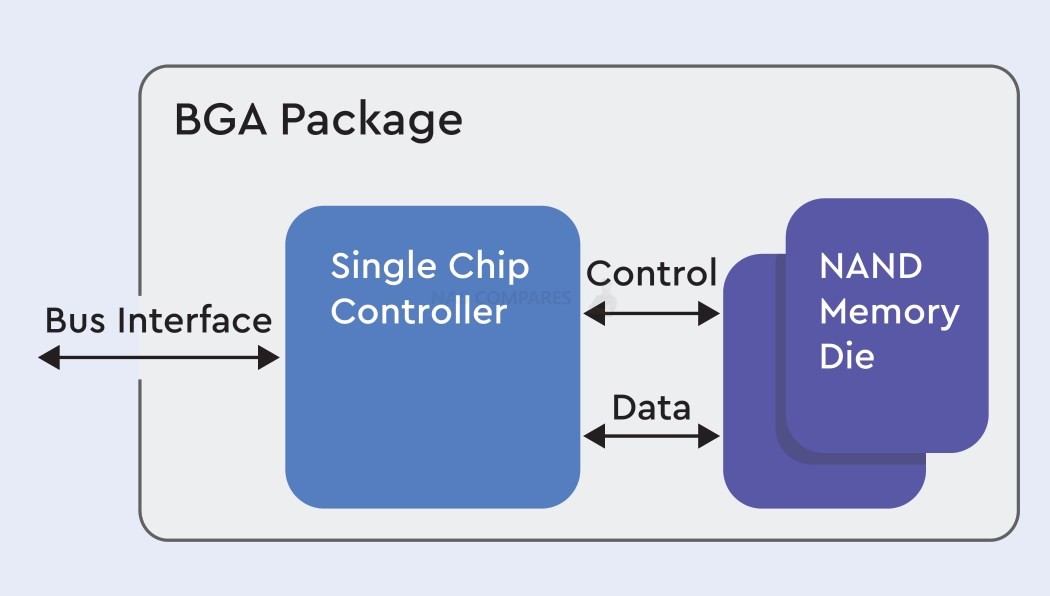
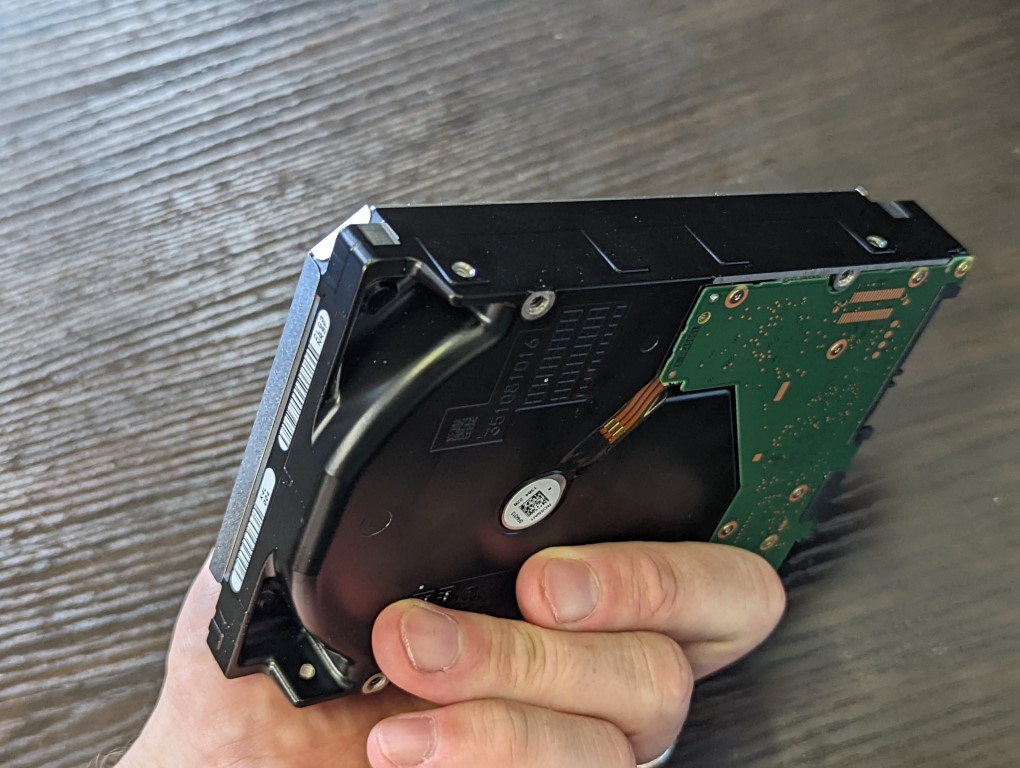
WD Ultrastar HC560 20TB Hard Drive Review – Design
The design of the WD Ultrastar HC560 20TB Hard drive is quite uniform when compared to the 16TB and 18TB versions of the same drive. The green PCB seemed the tiniest pinch thinner and less pronounced in this drive – likely due to every single millimetre counting in efforts to ensure that the drive is still a standard sized 3.5″ class HDD. Indeed, the newest generation of hard drives (i.e ones that use larger numbers of platters and helium sealing) tend to be considerably more solid and industrial in appearance than ever.
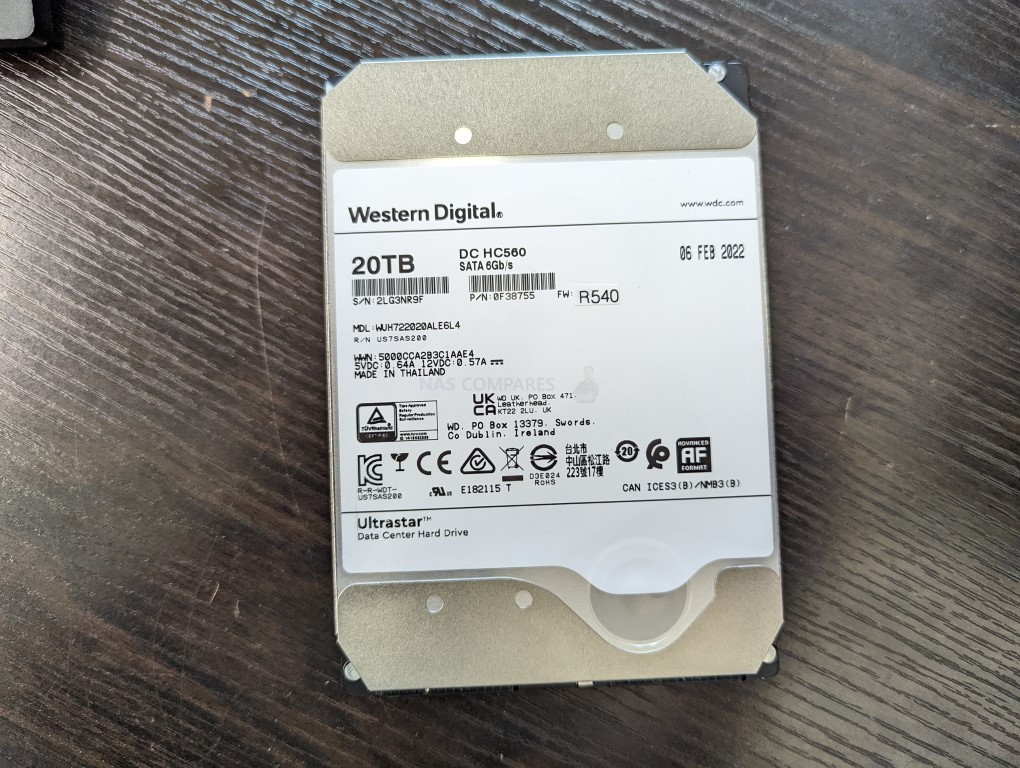
The top of the DC HC560 has the usual branded logos, technical details, firmware identification and date of production. The 20TB entries into the highly industry-favoured WD Ultrastar DC media range have arrived remarkably quickly with this drive being produced less than two months before the writing of this review. For a while, WD was noticeably slower on rolling out larger capacities since the 12TB and 14TB drive era, but in the last couple of storage tiers they have caught up considerably with their release frequency.
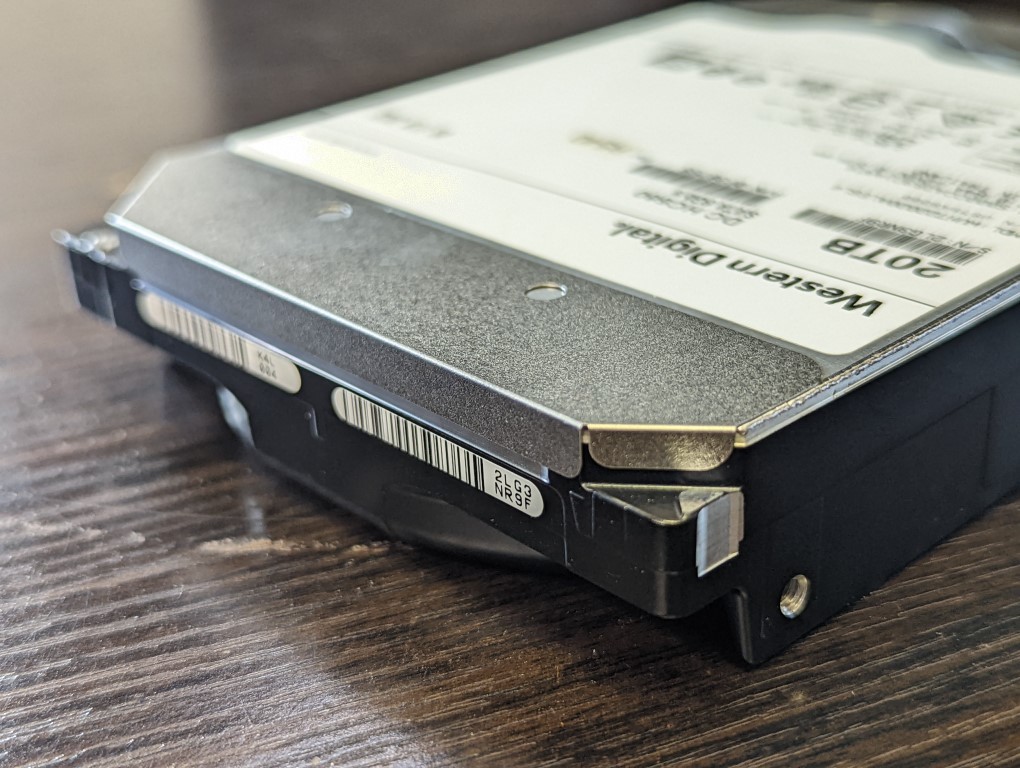
The sides of the WD Ultrastar HC560 20TB are quite standard and exactly what you might expect, completely sealed from all sides and feature the usual screw holes. The interface of the drive is a SATA data+power connector that does manage to give you a little perspective about the height of this drive and the density of those contained platters in this 2.61cm high media casing (it pretty much maximizes the full conventionally available space a 3.5″ can suitably occupy in any SAN/NAS server bay right now. This SATA port allows the drive to provide a reported maximum performance of 269MB/s Sequential Read (the tiniest pinch lower than the 272MB/s of the 18TB WD Ultrastar HC560) which is still remarkably impressive, almost halfway saturating the bandwidth of SATA and closing in on the speeds of early SSD technology in the late 00’s and early teens. It is also worth highlighting that (much like the rest of the Ultrastar range) the DC 560 20TB is available in SAS too, as well as arriving in a few different encryption standards inside (SED – self-encrypted drive) for industries that need secure read/write and secure erasure as standard).
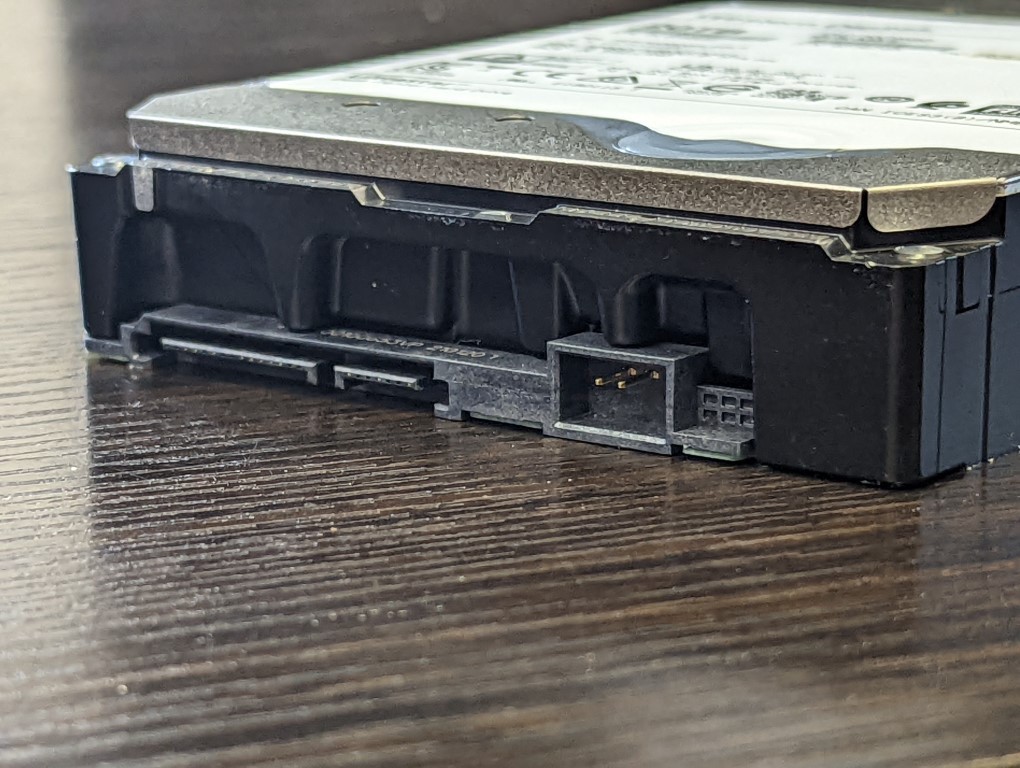
The bulk of that area is occupied by those nine platters that are being read by a triple-stage actuator (an advancement on the standard arm that engages with the platters to retrieve data). This TSA means that errors and performance issues that can be associated with disks built on denser drive platters are hugely negated. Whether you are looking at NAS drives, SAN/Data-Center drives or even regular single deployment domestic hard drives, the bigger the drive in capacity, the more susceptible a drive can be to even the smallest vibration or shock passing through it from the host system. How does the WD Ultrastar HC560 20TB counter this?
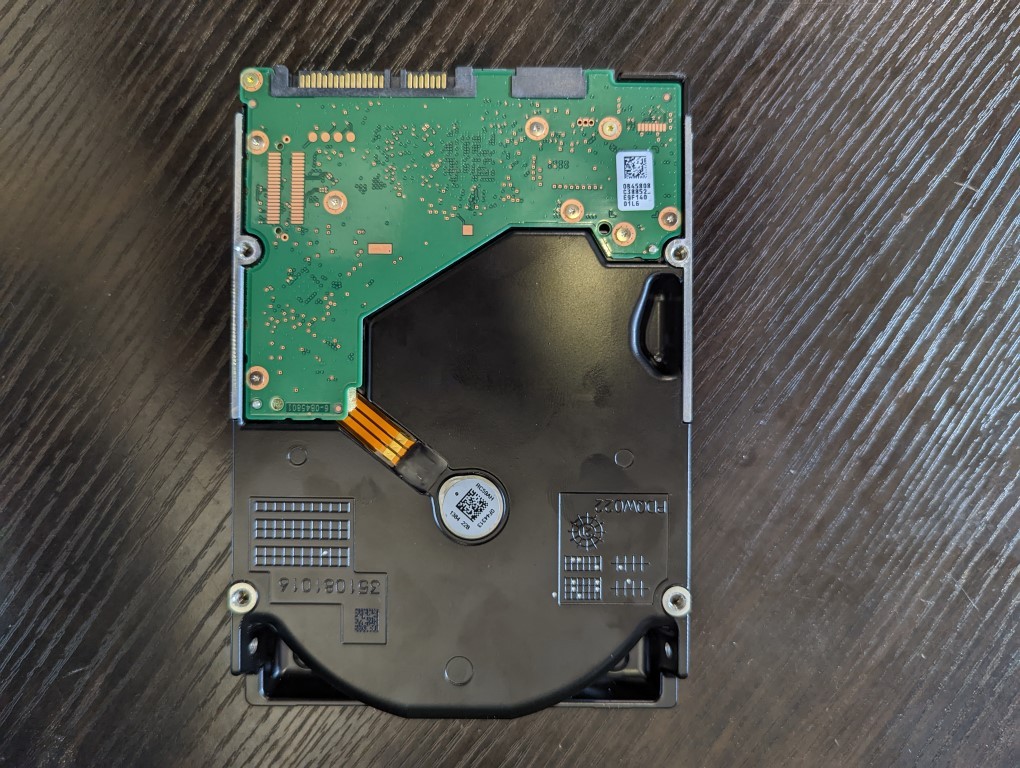
The 0F38755 20TB (much like the rest of the WD Gold and WD Ultrastar DC ranges in the larger capacities) hugely benefits from the multi-axis shocker sensor and 3D active balance plus in the framework and firmware of the HDD, which means the drive’s heads and platters have their generated vibration and ambient shock/vibration from the larger 24×7 server RAID configuration monitored and the drive proactively balances its performance. In short, this means that the drive can be more dynamic internally as surrounding system stress changes. Overall, what you have here is a very, VERY sturdy HDD. So, let’s see how that build quality translates into performance.
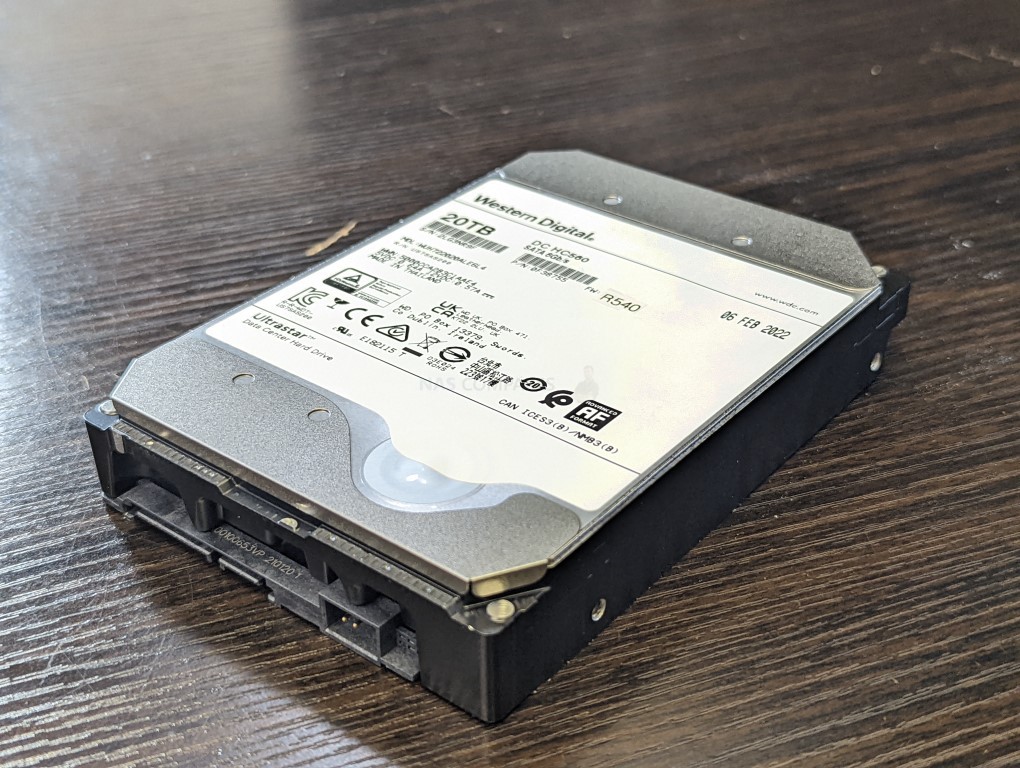
WD Ultrastar HC560 20TB Hard Drive Review – Testing
Testing the WD Ultrastar HC560 20TB is going to be performed across multiple methods, but still rather unconventional. This drive is designed for deployment in data center server environments of 12-24-36-48bays and higher. So, although I have several NAS in the studio that could accommodate frequencies of up to 12 bays of drives, I do not have multiple WD Ultrastar HC560 20TB units. Therefore the testing I have conducted are all examples of single-drive performance. These will include several PC testing sessions using popular and recommended storage testing applications and two NAS tests involving Synology and QNAP.
- Windows 10 Pro Desktop System
- Intel i5 11400 Rocket Lake – 6-Core 2.6/4.4Ghz
- 16GB DDR4 2666MHz Memory
- Intel B560M mATX Motherboard
- OS Storage, Seagate Firecuda 120 SSD
- Test Hard Drive connected to a Sabrent USB 3.2 Gen 2 10Gb/s external dock
- Synology test was conducted on a DS920+ NAS using the system’s own benchmarking tool (selected so we can isolate the sound level)
- QNAP test was conducted on a TS-464 NAS using the system’s own benchmarking tool (once again, to isolate the Ultrastar DC HC560 Noise level from the larger NAS system)
These last tests are important as not only is the WD Ultrastar HC560 20TB HDD designed for NAS use, but also at the time of writing neither brand lists this hard drive as compatible. There is more to this though that I will touch on later.
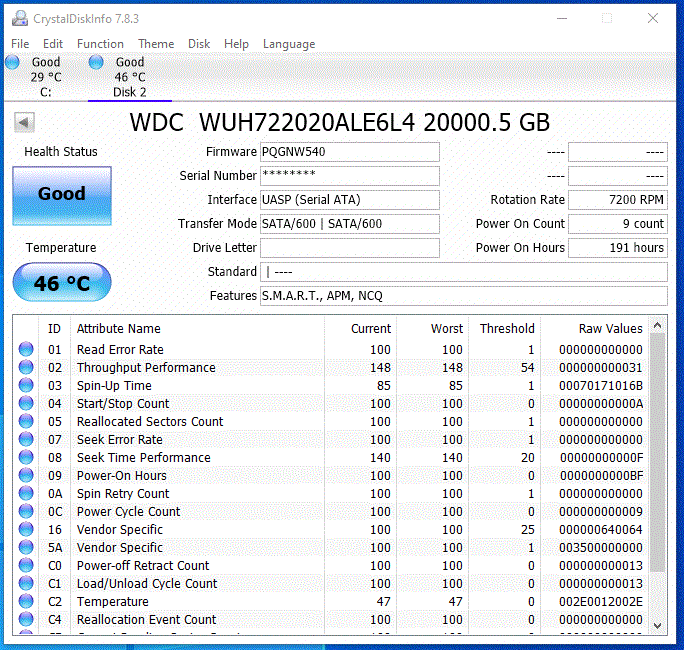
The first test involved using AJA. This test was using a 1GB and 256MB test file (one test using a 1080p format and another being a massive 4K media file test). Unlike previous tests of SSDs here on NASCompares, a 16GB fileover a SATA HDD will take quite a while and although it would be interesting to see how the WD Ultrastar HC560 20TB drive performs with this sustained largely sequential operation, I left heavy operations to later in the test routines.
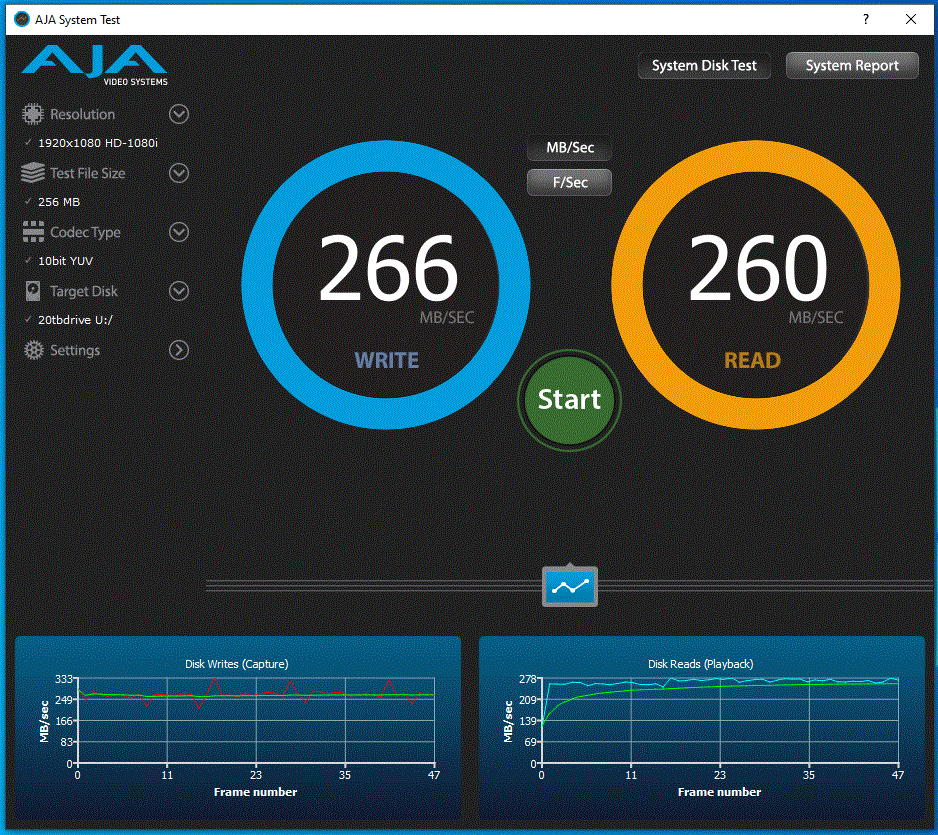 |
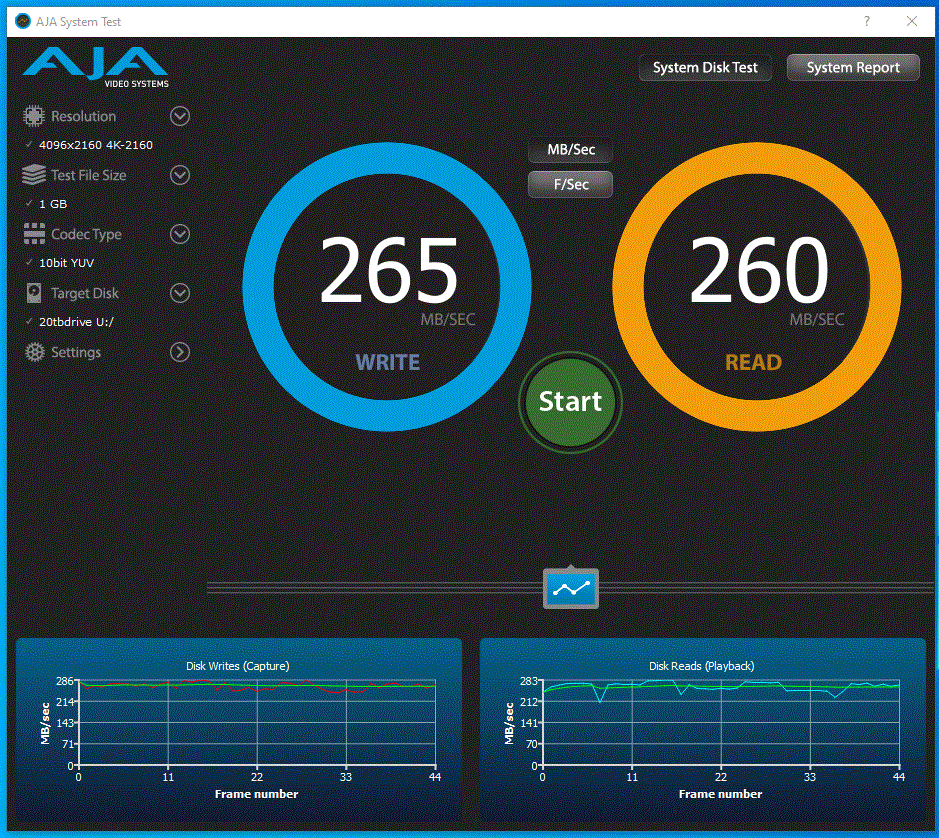 |
Next, I performed a quick test on CrystalDiskMark using a 64MB and 512MB test file, as well as mixed 70/30% R/W. The results were consistent and lived upto WD’s claims here.
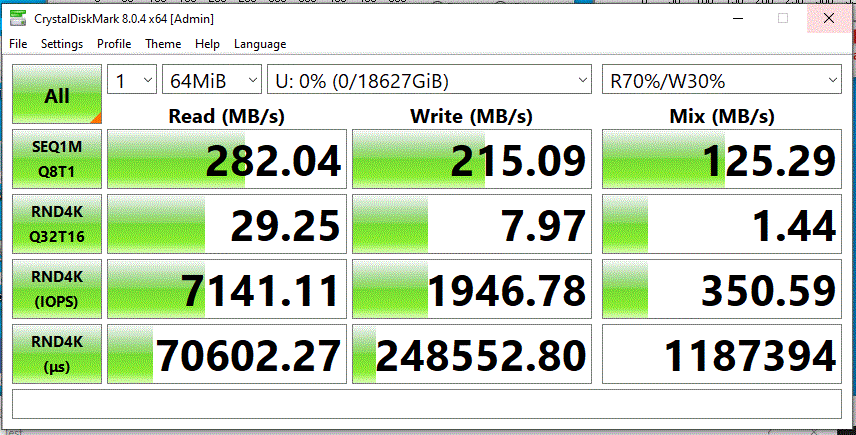
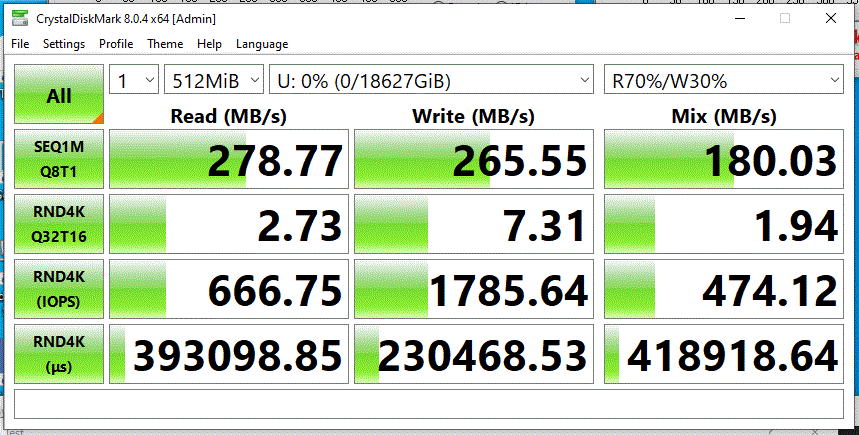
The next test was using ATTO disk benchmark and this one was using a 1GB and 256MB test file in the same windows PC test environment. However, this test was focused more on the IOPS. The random 4K operations of a hard drive will typically be hugely dwarfed by those of HDDs, but enterprise HDDs and pro series drives still tend to rate noticeably higher than domestic HDD and standard class NAS HDDs on this score. It is also worth highlighting that the 4K Random IOPS tests hugely demonstrated the noise level that this system can hit – which we will touch on later.
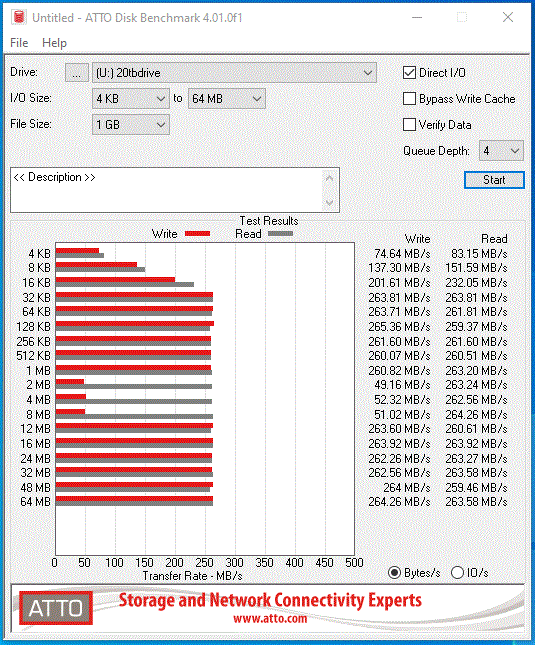 |
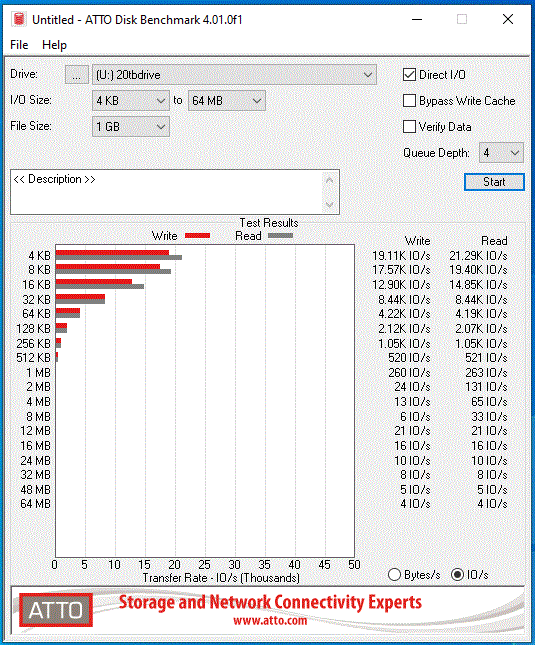 |
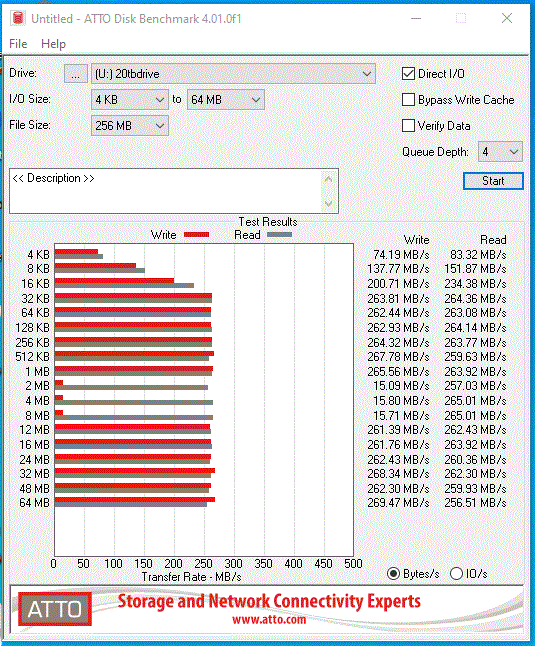 |
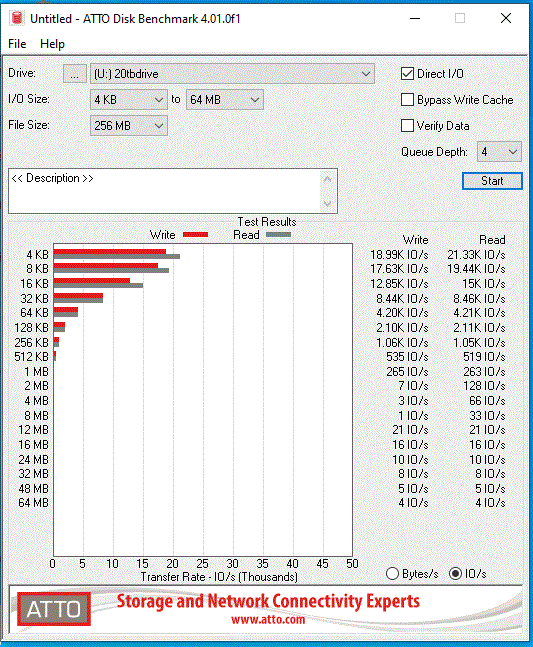 |
Finally, I conducted a straightforward transfer onto the HDD using Windows File Explorer. This was done with a folder filled with a little over 20GB of mixed file types and volumes (2,250 files across 71 folders). This transfer took a fraction under 2 mins:
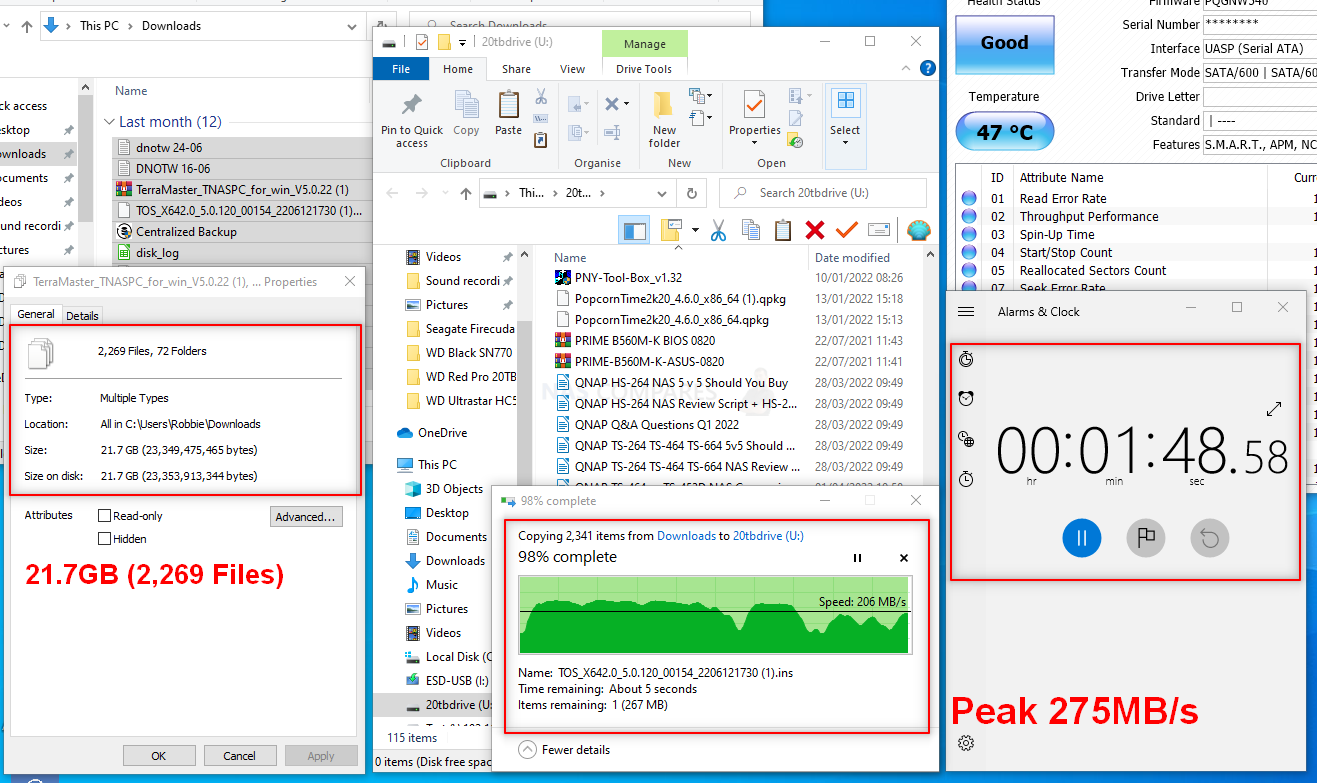
Synology & QNAP NAS Testing with the WD Ultrastar HC560 20TB Hard Drive
Now, before I move on to the NAS testing. It is worth highlighting a couple of important factors with regard to the WD Ultrastar HC560 20TB and the support available from each NAS brand I am focusing on for the testing. Now, Synology is the ONLY NAS brand in the market that also has its own first-party HDDs available to users too. These are Originally Toshiba Enterprise-grade produced hard disks that have had a Synology-specific firmware applied to them. Now, why is this relevant? Well, because some larger-scale Synology products in 2022 onwards do not list other 3rd Party HDDs as compatible. Even then, if you look up some of the older 2020 released NAS drives currently in the market (such as the DS920+ for example), they DO list HDDs from the likes of Western Digital (and their WD Red, Ultrastar and Gold series) BUT they do not list drives larger than 16TB at the time of writing. This is an odd stance by the brand, when larger-scale 18TB and 20TB hard drives are available in the market and designed for NAS.
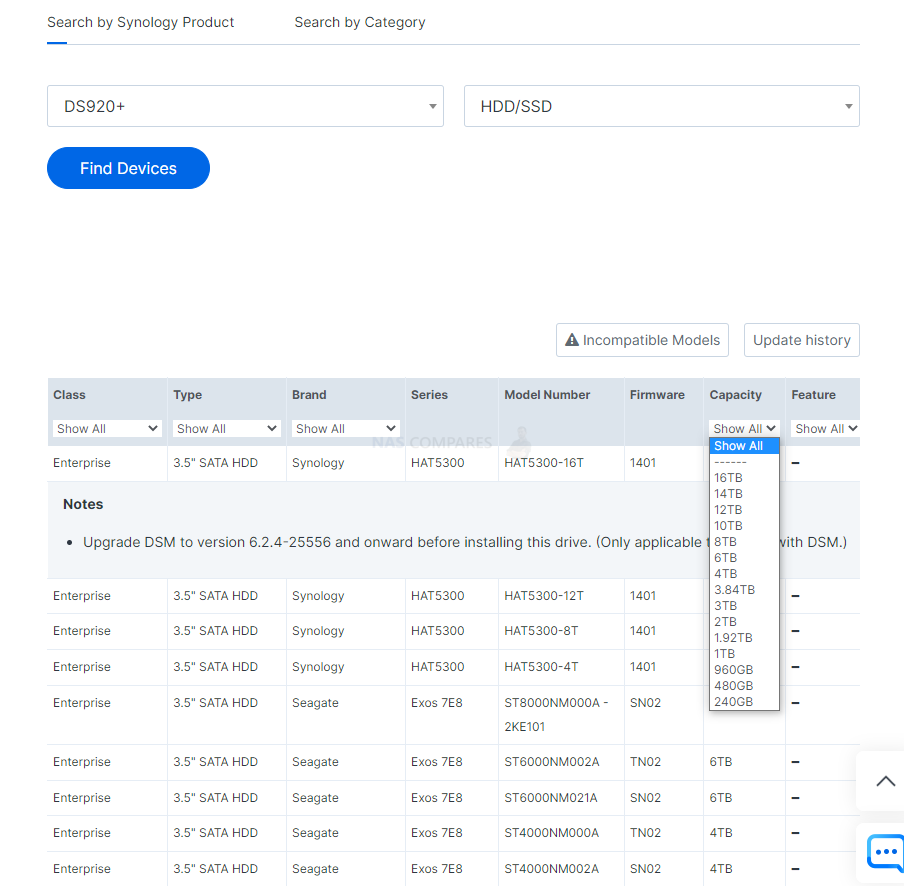
If you install an HDD or SSD inside a Synology system with the latest version of their software platform DSM, but the HDD in question is not on the compatibility list, you are greeted by a message that will detail that the drive is not recommended in the storage manager. You can still use the HDD for Storage Pools, Volumes, Hot-spares, etc, but it is an oddly jarring message for some.
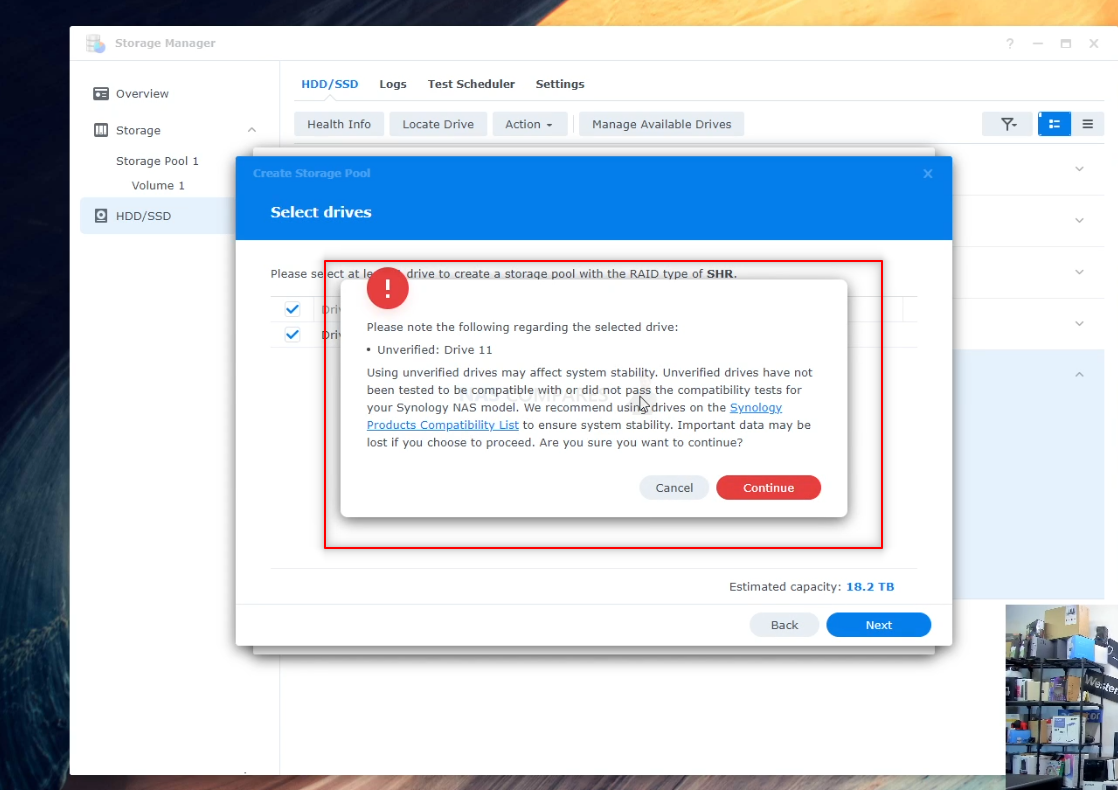
Of course, this is the current compatibility of this HDD at the time of writing and may well change in the future as further HDD capacities arrive and additional compatibility testing takes place.
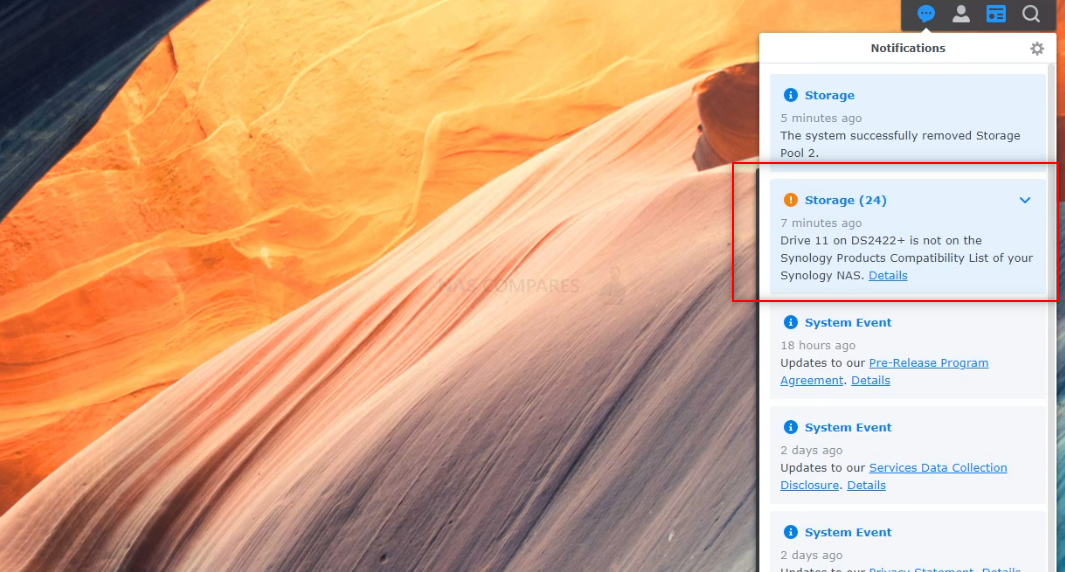
Nevertheless, you can still push through this warning and proceed to testing the performance of the WD Ultrastar HC560 20TB HDD from within the Synology Storage Manager. Here was the results.
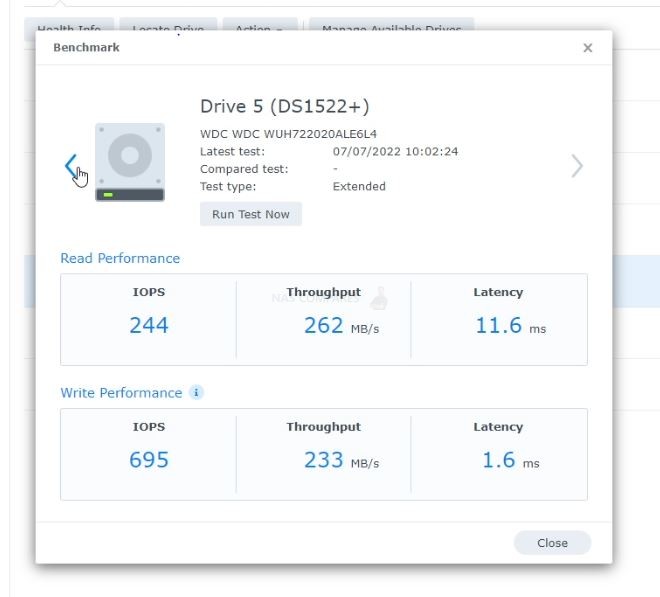
The HDD compatibility of the WD Ultrastar HC560 20TB Hard drive on the QNAP NAS platform is less complicated (eg the 18TB HDDs from most brands are listed) but at the time of writing the 20TB models are still not on the available list of compatible HDDs (again, this will likely be addressed shortly after commercial launch). Here is how the drive is benchmarked and appeared in the QNAP NAS system.
Noise Testing the WD Ultrastar HC560 20TB NAS Hard Drive
Another factor that is all too often overlooked is the noise that is generated by pro and enterprise-class hard drives. Because these larger capacity and more durable drives are built to provide as high a performance as possible, as well as survive the rigours of more industrial deployment, they end up being noticeably noisier in use. Now, in larger rackmount installations, the noise of the NAS system fans and operation will easily drown out the noise of HDDs. However, these things are much, much different in smaller-scale deployment. Now that most HDD brands have shifted their portfolios to only include 14/16TB media and higher to only exist in their Pro/Enterprise class tiers, those buying more modest NAS systems in the 1-8-Bay scale will be much more likely to hear the noise of these more enduring HDDs. The WD Ultrastar HC560 20TB is not an especially quiet drive when in operation and it has been designed with SIGNIFICANTLY LARGER server systems in mind. Therefore, even in idle, it makes a fair amount of noise when in operation. Here is how the drive sounds when the drive is powered on and on idle/standby (i.e no active file processes):
WD 20TB Noise in a Synology DS920+ NAS – IDLE (click below – you may need to grant permission/access in the browser)
And here is how the WD Ultrastar HC560 20TB sounds when the HDD is being HEAVILY accessed. using a benchmarking tool and extensive random 4K IOPS in read/write testing. Note, the higher the frequency of files, the noisier it will be, as the actuator inside will be working considerably hardware to allocate the small size/high frequency of data to the platters):
WD 20TB Noise in a Synology DS920+ NAS – HEAVY ACCESS (click below – you may need to grant permission/access in the browser)
Once again, if you are deploying this in a larger than 8-Bay NAS system (especially rackmount, but desktop too), then the clicks, hums and whirs of the WD Ultrastar HC560 20TB will not be especially noticeable above the general active fan noise of the host NAS system. But in smaller deployments and especially in setups where you will be in closer proximity with the NAS, this HDD will be especially noticeable and larger RAID NAS arrays will exacerbate the noise.
WD Ultrastar HC560 20TB Hard Drive Review – Conclusion
The Western Digital DC HC560 does exactly what it sets out to achieve. This is an incredibly robust hard drive that you can tell WD has poured alot of that enterprise audience R&D into! The fact that it is 20TB is always going to be impressive, but the real draw here is that this high degree of storage capacity has been achieved, without SMR and without compromising it’s performance and use in a larger RAID environment. HDDs are still in popular industry use and until the ongoing demand for Large Affordable Capacity AND fast access continues, you can see why most popular hard drive brands are predicted to comfortably hit 50TB by the end of the decade. The Western Digital DC HC560 20TB hard disk is a great piece of engineering that continues to support the continued popularity of the Ultrastar series for large-scale data center use. However, it is REALLY important to understand WHY this drive is DC/Data-Center classed and not appropriate for the average home user looking to get big capacity in a single drive. For a start, the Western Digital DC HC560 is a noisy drive! Alongside a higher power consumption to keep this industrial drive running 24×7, it is a drive designed for exceptional fast power on/spin up, as well as having a nine spinning platters to dance between all the time, so it makes alot of humming, spinning, vibrating and clicking noises throughout it’s operations – in a data center, fulling populating a 24 bay rackmount, you won’t hear it. But in a modest home 2-4-Bay system, it sounds horrendous! Enterprise drives like the Western Digital DC HC560 20TB are designed for larger scale deployment and used in bulk (RAID configs), hence the lower price often when compared again NAS PRO drives like WD Red Pro. The Western Digital DC HC560 Ultrastar is an exceptional Hyper-Scale storage hard drive, just don’t try to use it outside of those environments!
| PROs of the WD Ultrastar HC560 20TB | CONs of the WD Ultrastar HC560 20TB |
| 20TB for under £400 (i.e £20 per Terabyte, when the general market cost if £25-30) is an absolute solid WIN
Extremely well-constructed design 7200 + 512MB Cache + OptiNAND = Great hardware base to work with Sustained performance in testing stayed above 250MB/s over extended periods 550TB Annual Workload and 2.5 Million hr MTBF (even if you aren’t impressed by the latter scale in 2022) is huge;y impressive Considerably more available to buy online that you would expect, considering its a Data Center HDD |
Noisy!
Higher typical Power Use 1x 20TB drive, when you factor RAID = A larger, long term financial commitment to backups/redundency (often overlooked) |
🔒 Join Inner Circle
Get an alert every time something gets added to this specific article!
This description contains links to Amazon. These links will take you to some of the products mentioned in today's content. As an Amazon Associate, I earn from qualifying purchases. Visit the NASCompares Deal Finder to find the best place to buy this device in your region, based on Service, Support and Reputation - Just Search for your NAS Drive in the Box Below
Need Advice on Data Storage from an Expert?
Finally, for free advice about your setup, just leave a message in the comments below here at NASCompares.com and we will get back to you. Need Help?
Where possible (and where appropriate) please provide as much information about your requirements, as then I can arrange the best answer and solution to your needs. Do not worry about your e-mail address being required, it will NOT be used in a mailing list and will NOT be used in any way other than to respond to your enquiry.
Need Help?
Where possible (and where appropriate) please provide as much information about your requirements, as then I can arrange the best answer and solution to your needs. Do not worry about your e-mail address being required, it will NOT be used in a mailing list and will NOT be used in any way other than to respond to your enquiry.

|
 |
Beelink ME Pro NAS Revealed
Best SOLID STORAGE NAS of 2025
Should You Worry About the NanoKVM Hidden Microphone?
Best Cheap NAS of 2025
Minisforum MS-02 Ultra - WHO IS THIS FOR??? (The First 48HRs)
Why People Use TrueNAS, UnRAID and Proxmox to Turnkey NAS (Synology, QNAP, etc)
Access content via Patreon or KO-FI
Discover more from NAS Compares
Subscribe to get the latest posts sent to your email.


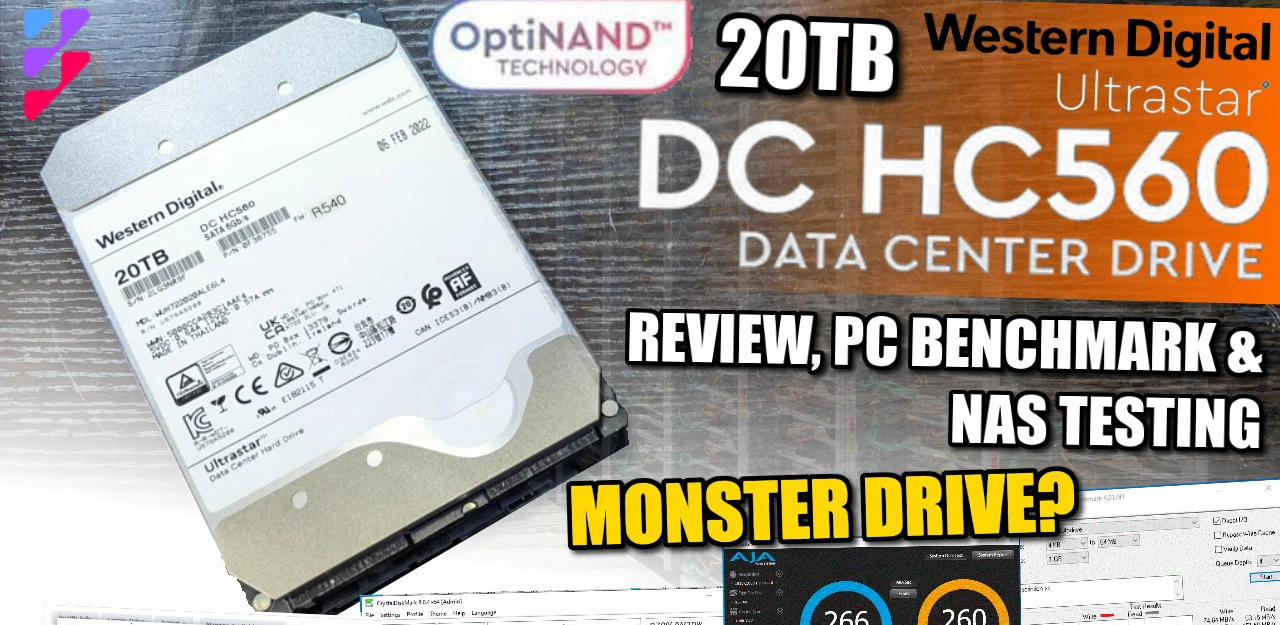
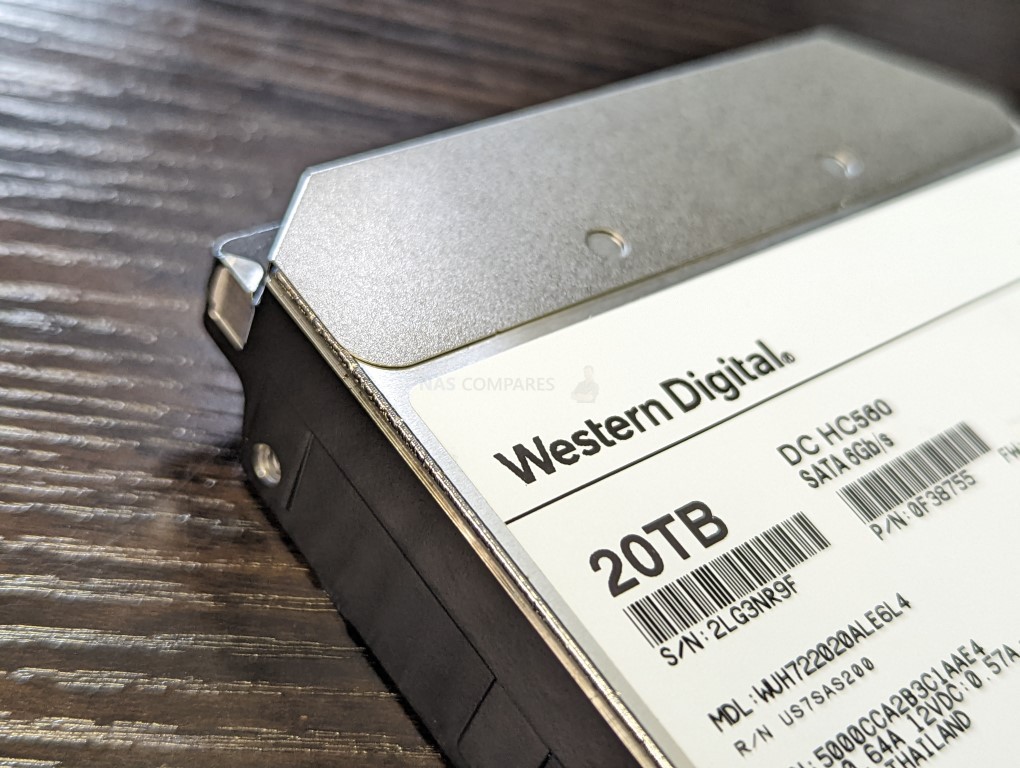
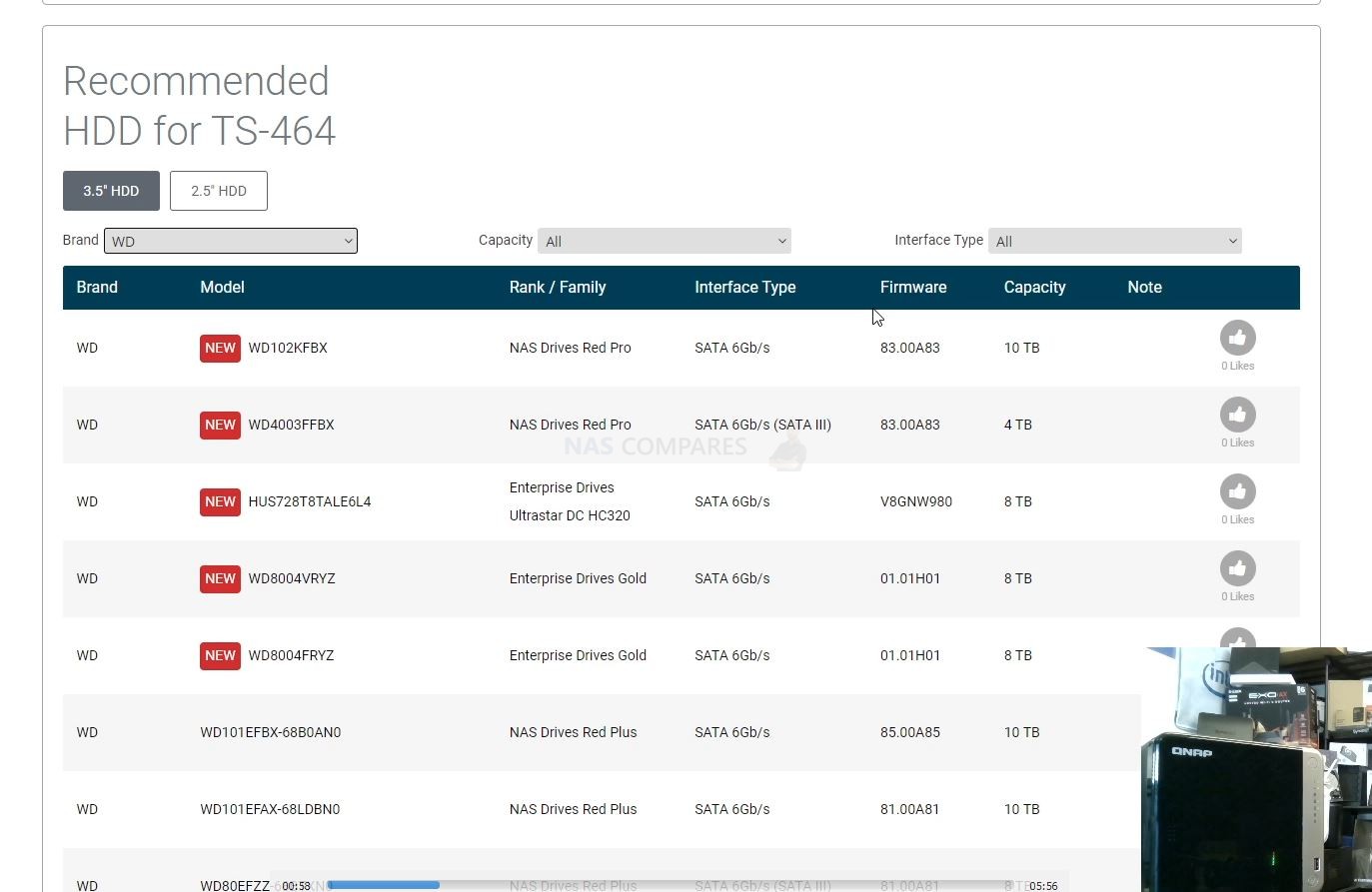
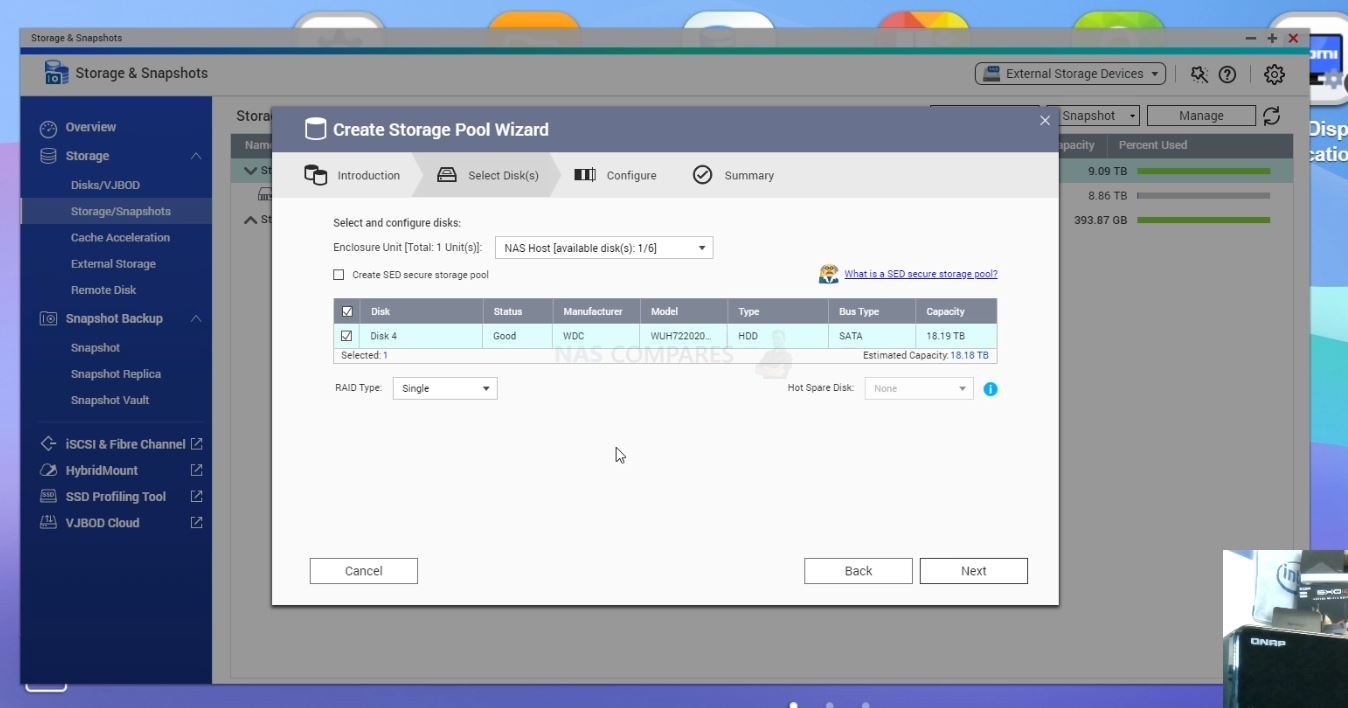
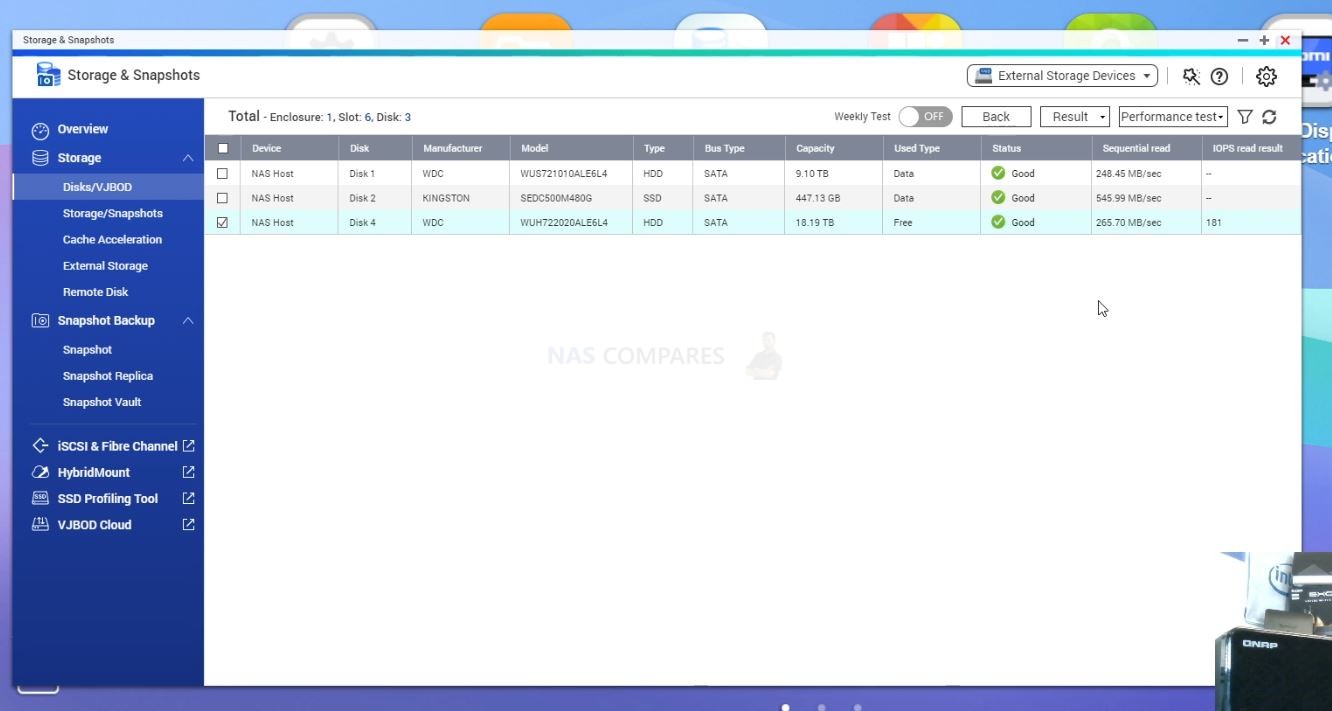
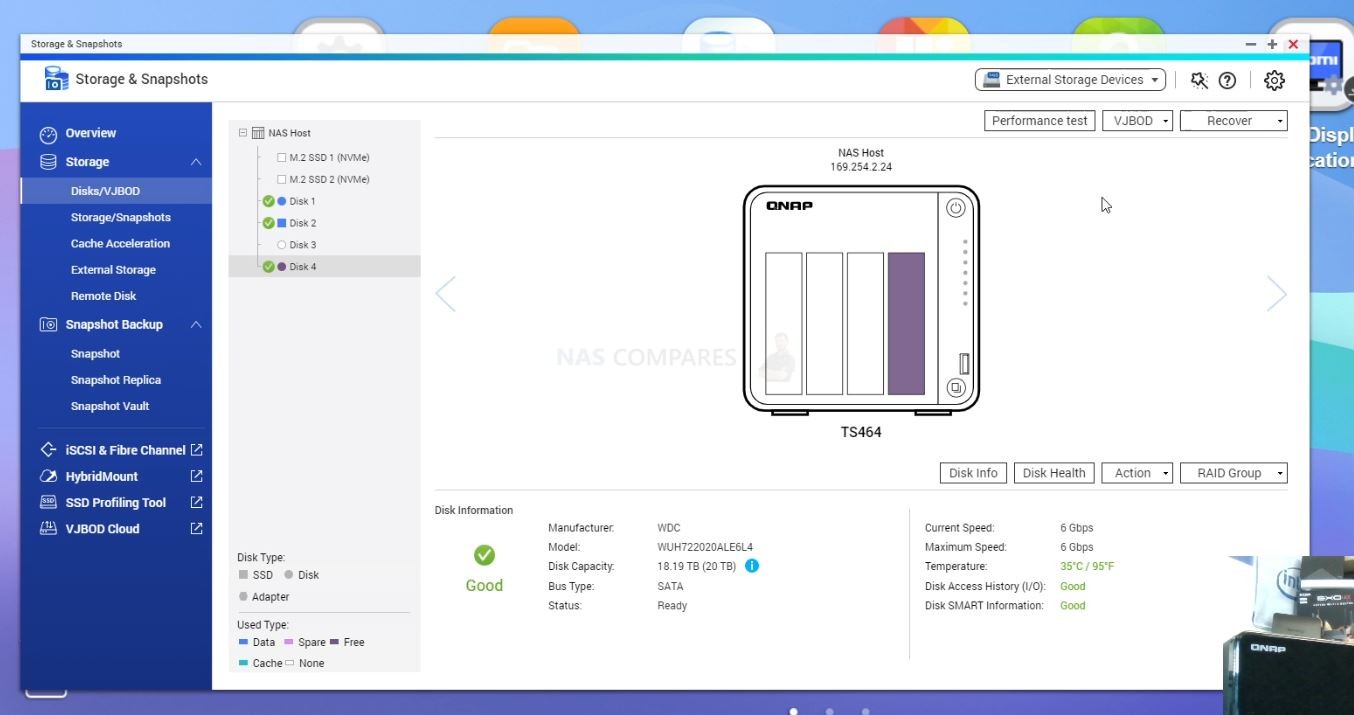




I love the gulls in the background! It threw me off there for a second as I thought they were here outside my house ????????????. Great way to distinguish your channel from the others….and it doesn’t cost a thing, right?
REPLY ON YOUTUBE
Pls review HC 580 24tb
REPLY ON YOUTUBE
“I hate seagulls” **has a stuffed bird on the desk** ????
REPLY ON YOUTUBE
Ok…. soooo…. What do you recommend for home use with plenty of storage???
REPLY ON YOUTUBE
What is louder? An array of 12 ultrastars or a single seagull?
REPLY ON YOUTUBE
He complains a lot about the “nose” even though it’s doing random access (the most stressful thing a hard drive can do) close to the mic and you can still barely hear it going his breathing is louder then the hard drive
REPLY ON YOUTUBE
Check out how he gently handles the hard disk. He really appreciates and respects the artifacts, unlike the monkeys we see on other channels.
REPLY ON YOUTUBE
I don’t know what you mean about the HC560 being ‘noisy’. I own two 18 TB HC550s which I use in high-end tower type home PCs. The HC550 and HC560 are identical drives aside from the Optinand and tpi. Both have 9-platters/ 18-heads (the 550 was the Words-First 3.5 in drive with 9-platters). My first drive was a premium MiniScribe 3053 5.25 inch unit with 3-platters. I enjoyed being able to easily hear it work (and it spun at only 3600 rpm)—the Ultrastars are silent by comparison—technically awesome devices.
REPLY ON YOUTUBE
I DONT UNDERSTAND THE NAMING CONVENTION!!! Which is new, which is older model? is HC560 older which is newer? obviously HC560 is older given the age of the video
REPLY ON YOUTUBE
It makes you wonder if at any point to cram more data in, if they would increase the platter size physically and give oh I dunno a 5.25″ hard drive!
REPLY ON YOUTUBE
Thank so much !
REPLY ON YOUTUBE
Great drives but I remember my first Ultrastar, they got called Deathstar as so many broke back then.
REPLY ON YOUTUBE
You saved me several times from buying enterprise level hdds which I thought would be better because of lower price and theoretical better performance, but which nobody says that are much much noisier and which is a very important point for a consumer. Now, which high capacity drive do you recommend me for having at home in a room where I do remote work most of the day? Thanks!
REPLY ON YOUTUBE
I have had this thought banging around in my head, what would the capacity be if we returned to the 5.25 hard drive standard?! Also, I hate seagulls.
REPLY ON YOUTUBE
I bought a second-hand 10TB Ultrastar-HCC510 – and then “by habit” tested it on a Desktop – with a 2021-model Motherboard from Asus.
..
And, you will probably correct me – but, I was surpriced to discover, that it was not recognized.
I then updated my bios to the latest – same result..
I then got anxious – had the person sold a faulty drive to me…
But .. – sorry, a Seagull distracted me, for a moment (I needed to load my shotgun, and try to hit it???? – which succeeded after some shots .. now I await the local police, since it is Denmark) – .. it works 100% on my NAS’es (Terramaster, Qnap).
Being an amateur, and not having tried to put an “enterprise hdd” into a Desktop-PC before – I was surpriced!
And, especially surpriced, because the drive is old, and could have been testes, by someone else, before me.
(As it is, now, I have written to Asus – because, it is very okay, as an upgrade – to my PC’s 4TB file-storage & backup-drive (bought back in 2014 !!)).
[regarding old drives (2014): I am triple-securing /backing-up all my data – so a failing HDD is not a (big/essential) problem for me… on my desktops]
[actually, I have not had a HDD failing, since 1999…]
[my oldest drives, currently still in use, is bought back in 2009! (!)]
REPLY ON YOUTUBE
Neeed Helium Ultrastar DC HC560 & Nomal HDD SOUND TEST open nacked please
REPLY ON YOUTUBE
keep in mind, that a an enterprise disc, in sata, looses half of it’s databus speed, SAS is able to write/read at the same time, and yes, I run these drives
REPLY ON YOUTUBE
My HC550 18Tb is quieter and faster than my red pro, and red plus, and way quieter than my WD Black.
I run it bare on my desk as an archive drive. Only thing I have is a small usb fan to keep it cool. (Also keeps me cool.)
I choose it for its durability, and reliability.
REPLY ON YOUTUBE
Hearing your battle and struggle over the years with seagulls has been hilarious!
Best in depth reviews and analysis.
Great work and appreciate the all of the effort you put in.
REPLY ON YOUTUBE
Thanks for the noise test! I’d like to know, within a product line, how the noise increases as a function of storage capacity. Can you make a video about this with eg WD Red Plus from 8-20TB?
REPLY ON YOUTUBE
Hello. I have an Asus Pro Ws x570-Ace motherboard. I want to upgrade to this hard drive. HC570 22tb. Windows 10 Pro. I want to connect to U2 with Sata mode.
But wd says its only enterprise at support message. And Asus doesn’t guarantee compatibility. I don’t mind the noise. Workstation is on separated house compartment. Do you think it’s safe to buy it or should i spend more money on a gold version for example.
REPLY ON YOUTUBE
Not all enterprise harddisk are loud. I got HC550 running on a dock for archiving. Its whisper quiet.
REPLY ON YOUTUBE
Helium is notoriously difficult to keep contained! no seal, not matter how perfect can keep it contained. Maybe if you weld the drive together, you might make a helium-proof case. So will the drive continue to work when all the helium leaks out after a few years?
REPLY ON YOUTUBE
Just for statistics for anyone:
Bought 4 on 6th August last year and yesterday (22nd June) one stoped to report back to controller and is now a brick on it’s way to supplier. Good thing is that this drive has a 5 year warranty.
Some additional info, the drive is laud. Technically it’s the same sound level that other drives have, however the transient is far more pronounced and is shakes the enclosure a lot.
REPLY ON YOUTUBE
6:00 – “This is in terms of hard drives, very close to the top tier, because this is “I Hate Sea Gulls”” ????????????
REPLY ON YOUTUBE
I have a 5 bay Synology with all 18tb from the Best Buy shuck special, I’m building a second 5 bay and noise is an issue. I’m fine with my current setup however considering upgrading to Ultrastar 20tb or 22tb….would I see more noise compared to the wd or Ultrastar 18tb? Enough to avoid using if noise is an issue?
REPLY ON YOUTUBE
Are you doing the review on a boat lol, the seagulls are going nuts haha! Anyways, I’m getting this, but I heard it wont work on a PC cus its SAS or something, not SATA. I wonder whats the deal with that? Thats the only 1 they sell here from what the store owner said to me? Hmm.
REPLY ON YOUTUBE
@ 12:43 ????????????
REPLY ON YOUTUBE
There is nothing wrong with getting milk in a Ferrari. Mazerati? Well I don’t know anything about that
REPLY ON YOUTUBE
My quick chatbox math says the drive is rated at 550 TB/y. That amounts to only 23 days of constant use at 269 MB/s. Is that actually the case?
REPLY ON YOUTUBE
the elephant in the room is how horrible your teeth is.
REPLY ON YOUTUBE
Very nice review, thank you!
You don’t recommend it for regular desktops or even home NAS but what other options are there when you want a 20TB drive?
I currently own a few 10TB WD Red NAS drives but the HC560 20TB is at its lowest price in 6 months in my area so I am actually thinking about purchasing one.
EDIT: I am out of physical space in my desktop PC and having 4x 10TB Red NAS drives is cranking up the heat so much it’s at the edge over overheating during summer. I must say my case is actually a sound dampened one with poor airflow…
That’s also the reason I’m considering replacing the 4 drives with 2 of these HC560 20TB drives.
REPLY ON YOUTUBE
Thanks
Got one of the for my pc.
Installing it was easy, just plugged it in as normal and initialised it in windows. (Single drive no raid). This 20tb drive is actually not that loud if you write single big files to it in sequence. But with random read/writes it makes a rackle as described. But since I use it for storing single big HQ 4K and 8k files, it’s fairly quiet, and all I hear is my fans (I do my video editing on m.2 drives).
I also have it on rubber mountings In my cabinet.
REPLY ON YOUTUBE
26TB is already out (6 months ago).
REPLY ON YOUTUBE
My new Steam drive.
REPLY ON YOUTUBE
How do you get WD Ultrastar to work on a regular pc? I have ssd one
REPLY ON YOUTUBE
Already have two of those drives in my computer for about 5-6 months, trying to get third one, missed out on lowest pre-order sale at 350gbp per drive, when pound dropped – price gone up to 566gbp then I’ve waited and price dropped down to 407gbp after a week or so thus jumped on third drive and pre-ordered it but, stock is yet to arrive at Scan…
REPLY ON YOUTUBE
If they are anywhere near as reliable as the old HGST platform they are designed from these will last a very very long time.
REPLY ON YOUTUBE
awesome video dude!
REPLY ON YOUTUBE
Genius, that’s because it is a shite, cheap enclosure and the drive is rattling around in the there causing noise.
What you are basically saying is, “Don’t buy a craptastic Synology NAS enclosure”.
Don’t blame the drive for the inadequacies of the enclosure.
REPLY ON YOUTUBE
What the fuck are you talking about with “Noisy”?
I have Ultrastar 14 TB and 16 TB drives and you just can’t hear them.
Of course I buy the Enterprise drives, because they are cheaper than the far inferior “NAS” drives and they have 512 MB of cache which makes a big difference in speed.
“They make a big old racket when they are working” – that’s utter bullshit.
REPLY ON YOUTUBE
I just bought 3 of these. If they are any were near reliable as the old HGST platform they are designed off of. These will last a very very long time
REPLY ON YOUTUBE
@NASCompares: is noise level of WD Gold 20Tb the same? Is Gold any better for NAS use or just branding? thx
REPLY ON YOUTUBE
I have an external OWC hard disk enclosure. In it I have 2 18 TB Ultrastar’s. Yes, they area little noise but I actually enjoy it.
When the RED drives on my WD EX4100 NAS die I will buy Ultrastar’s oy maybe WD Gold’s. The RED’s are pointless in my opinion.
REPLY ON YOUTUBE
I fucking weep seeing $525 CAD for this drive, a currency more or less the same as my AUD…. and yet the drives are $1,100 here :'(((
REPLY ON YOUTUBE
How loud is it (decibels)? Without using a standardized SPL measurement, it’s impossible to tell. Even your video audio gain levels vary substantially from video to video. So getting an actual measurement…. The variances are too great to arrive at a reasonably comprehensive audio level between the “deltas”.
REPLY ON YOUTUBE
Still waiting for Synology 20TB drives. ????
REPLY ON YOUTUBE
Still waiting for Synology 20TB drives. ????
REPLY ON YOUTUBE
I think one of the biggest things you left out was the amount of seagulls you can store on a 20 tb drive. LOL You should do a 5 star rating but instead of stars a 5 seagull rating 🙂 great work thanks for sharing and you do amazing work.
REPLY ON YOUTUBE
I think one of the biggest things you left out was the amount of seagulls you can store on a 20 tb drive. LOL You should do a 5 star rating but instead of stars a 5 seagull rating 🙂 great work thanks for sharing and you do amazing work.
REPLY ON YOUTUBE
Are they really that noisy? I’ve seen some noise charts of the 16TB ultra and isn’t that much more on paper, yes being quite & less power draw is good but I can’t validate spending 20% more money for a product that is less durable like surely one should be able to try and build a sound damping enclosure or something
REPLY ON YOUTUBE
Are they really that noisy? I’ve seen some noise charts of the 16TB ultra and isn’t that much more on paper, yes being quite & less power draw is good but I can’t validate spending 20% more money for a product that is less durable like surely one should be able to try and build a sound damping enclosure or something
REPLY ON YOUTUBE
I only run enterprise drives in my main NAS. Toshiba is a brand hardly mentioned on here but they tend to be the cheapest drive in the UK (aside from the ones rebranded by Synology) and when it comes to noise they are as least as quiet as any other large capacity drive. Great drives, great performance, reliable and at a very good price.
REPLY ON YOUTUBE
I only run enterprise drives in my main NAS. Toshiba is a brand hardly mentioned on here but they tend to be the cheapest drive in the UK (aside from the ones rebranded by Synology) and when it comes to noise they are as least as quiet as any other large capacity drive. Great drives, great performance, reliable and at a very good price.
REPLY ON YOUTUBE
I want those two minutes of my life back.
REPLY ON YOUTUBE
I want those two minutes of my life back.
REPLY ON YOUTUBE
Is EAMR a proven technology?
REPLY ON YOUTUBE
Is EAMR a proven technology?
REPLY ON YOUTUBE
I have two of the 18TB versions of this drive in a DS1520+ and they are doing perfectly fine. I dont see any reason to pay extra for a WD RED or Ironwolf.
REPLY ON YOUTUBE
I have two of the 18TB versions of this drive in a DS1520+ and they are doing perfectly fine. I dont see any reason to pay extra for a WD RED or Ironwolf.
REPLY ON YOUTUBE
I want to know how the Toshiba MG07 & MG08 drives perform
REPLY ON YOUTUBE
I want to know how the Toshiba MG07 & MG08 drives perform
REPLY ON YOUTUBE
I am consistently annoyed at drive capacity ratings being much higher than that of a typically formatted drive. As drive architectures hold greater and greater capacities that much more total space is consumed for non-usable purposes. Drive manufacturers know that people do not run uninitialized and unformatted drives in our systems yet they continue to quote a drive capacity of 20TB when in actuality it is about 10% less at 18.2TB when initialized and formatted. It’s like the gas stations that still charge that 9/10 of a cent per gallon of gas on top of the dollar and cents price here in the US. Who are these people kidding?
REPLY ON YOUTUBE
I am consistently annoyed at drive capacity ratings being much higher than that of a typically formatted drive. As drive architectures hold greater and greater capacities that much more total space is consumed for non-usable purposes. Drive manufacturers know that people do not run uninitialized and unformatted drives in our systems yet they continue to quote a drive capacity of 20TB when in actuality it is about 10% less at 18.2TB when initialized and formatted. It’s like the gas stations that still charge that 9/10 of a cent per gallon of gas on top of the dollar and cents price here in the US. Who are these people kidding?
REPLY ON YOUTUBE
Am I the only one who notices that sound and picture are out of sync?
REPLY ON YOUTUBE
Am I the only one who notices that sound and picture are out of sync?
REPLY ON YOUTUBE
20TB HDD?!?!
Step it up to 100TB SSD!
REPLY ON YOUTUBE
20TB HDD?!?!
Step it up to 100TB SSD!
REPLY ON YOUTUBE
I don’t agree with your assessment Rob, these are awesome in regular DS’, been running them for years. TBH if you are looking at NAS pro drives, go for enterprise. Ofc unless you have a fairly remote location like a basement/attic/garage not sensitive to noise to place it, don’t choose these. But this is also true for pro drives, I believe your earlier noise test proved as much.
REPLY ON YOUTUBE
I don’t agree with your assessment Rob, these are awesome in regular DS’, been running them for years. TBH if you are looking at NAS pro drives, go for enterprise. Ofc unless you have a fairly remote location like a basement/attic/garage not sensitive to noise to place it, don’t choose these. But this is also true for pro drives, I believe your earlier noise test proved as much.
REPLY ON YOUTUBE
On QNAP, as the legend says purple means free (a disk not yet used for either data, spare or cache). Nothing to do with compatibility lists 😉
But that’s nitpicking, nice video although I’ll avoid these drives due to their noise. And guess who helped me decide that.
REPLY ON YOUTUBE
On QNAP, as the legend says purple means free (a disk not yet used for either data, spare or cache). Nothing to do with compatibility lists 😉
But that’s nitpicking, nice video although I’ll avoid these drives due to their noise. And guess who helped me decide that.
REPLY ON YOUTUBE
“I hate seaguls”
REPLY ON YOUTUBE
“I hate seaguls”
REPLY ON YOUTUBE
Before anyone frags you for your spelling of Neighbours ( not Neighbors ), that is how the word – proper noun or not, is spelled in the world outside of the U.S. Yes, I know, far too many people don’t know the difference between you’re and your so I’m not expecting too many to even notice. But, just in case…
REPLY ON YOUTUBE
Before anyone frags you for your spelling of Neighbours ( not Neighbors ), that is how the word – proper noun or not, is spelled in the world outside of the U.S. Yes, I know, far too many people don’t know the difference between you’re and your so I’m not expecting too many to even notice. But, just in case…
REPLY ON YOUTUBE
Nice breakdown of the differences in the drives. The drive noise (along with heat) are exactly why my 12 and 8 bay NAS’ are in the basement. I only keep the 6-bay full of SSD’s in my office.
REPLY ON YOUTUBE
Nice breakdown of the differences in the drives. The drive noise (along with heat) are exactly why my 12 and 8 bay NAS’ are in the basement. I only keep the 6-bay full of SSD’s in my office.
REPLY ON YOUTUBE
Hahaha! “I hate Seagulls”. Thanks for the content, long time viewer, just sub’ed.
REPLY ON YOUTUBE
Hahaha! “I hate Seagulls”. Thanks for the content, long time viewer, just sub’ed.
REPLY ON YOUTUBE
Got a 16TB white label drive shucked from a WD Elements. Turned out to be a relabled Ultrastar and boy is it noisy!
Idle is OK but seek noises are ridiculous even more than old IBM drives which even at idle make a racket!
P.s. Audio is out of sync from the beginning.
REPLY ON YOUTUBE
Got a 16TB white label drive shucked from a WD Elements. Turned out to be a relabled Ultrastar and boy is it noisy!
Idle is OK but seek noises are ridiculous even more than old IBM drives which even at idle make a racket!
P.s. Audio is out of sync from the beginning.
REPLY ON YOUTUBE
Just picked up a few of these myself for my first Unraid build ????
Now, time to watch the video, and find out that was a big mistake ????♂️ lol
REPLY ON YOUTUBE
Just picked up a few of these myself for my first Unraid build ????
Now, time to watch the video, and find out that was a big mistake ????♂️ lol
REPLY ON YOUTUBE